

El gusano - Roberto Bolaño. Lengüetrazos: Buenas Ideas Circulando: la creatividad en tableros de Pinterest. Paseando por los diferentes tableros, siempre descubro cosas interesantes, útiles, divertidas, emocionantes, creativas y me gusta deleitarme con las imágenes de algunos compañeros, descubrir cuáles son sus gustos, cómo organizan sus pines, conocer ilustradores, coger ideas para reciclar, jugar con peques, qué libro leer, reírme con algún chiste...
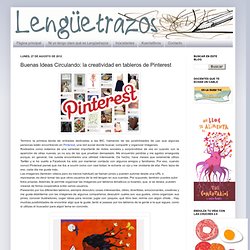
Hay muchas posibilidades de encontrar algo que te guste, tanto si paseas por los tableros de la gente a la que sigues, como si utilizas el buscador para algún tema en concreto. Solo por estos motivos yo ya recomendaría Pinterest, siendo consciente de que "para gustos están las redes sociales", pero es que además en ella he encontrado algunos tableros que me parecen auténticas Buenas Ideas Circulando, que me han llevado a escribir este post. Como los tableros de los que voy a hablar son compartidos, no estoy segura de qué cabecita nació la idea para cada uno de ellos. Pero la lectura en el aula conlleva otro tratamiento. 4843Castedo.pdf.
3750Gonzalez.pdf. Molinos de papel: proyecto de animación. Fundamentación.

Jean-Baptiste Michel + Erez Lieberman Aiden: What we learned from 5 million books. Science-vs-humanities.jpg (JPEG Image, 483 × 611 pixels) Move over, Stem: why the world needs humanities graduates. On the third day God created Stem subjects?
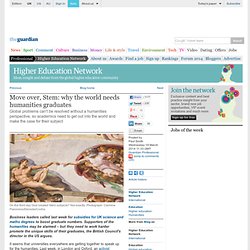
Not exactly. Photograph: Carmine Flamminio/Demotix/Corbis Business leaders called last week for subsidies for UK science and maths degrees to boost graduate numbers. Supporters of the humanities may be alarmed – but they need to work harder promote the unique skills of their graduates, the British Council's director in the US argues. It seems that universities everywhere are getting together to speak up for the humanities. And the debate won't stop at the college walls.
Online Art Education Degree. Science, technology, engineering and mathematics are the center of attention in most US public schools today.
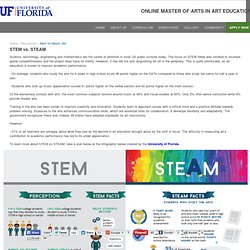
The focus on STEM fields was initiated to increase global competitiveness and the project does have its merits. However, it has left the arts languishing far off in the periphery. This is quite unfortunate, as art education is known to improve academic performance. - On average, students who study the arts for 4 years in high school score 98 points higher on the SATs compared to those who study the same for half a year or less. - Students who took up music appreciation scored 61 points higher on the verbal section and 42 points higher on the math section. Of the elementary schools with arts, the most common subjects revolve around music at 94% and visual studies at 83%. Training in the arts has been shown to improve creativity and innovation. However: - 51% of art teachers are unhappy about what they see as the decline in art education brought about by the shift in focus.
STEM or STEAM? We're Missing the Point STEM education is one of the most talked about subjects in our country today — and for good reason.
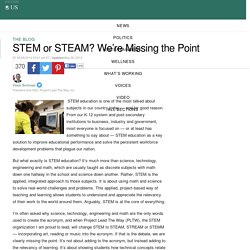
From our K-12 system and post-secondary institutions to business, industry and government, most everyone is focused on — or at least has something to say about — STEM education as a key solution to improve educational performance and solve the persistent workforce development problems that plague our nation. But what exactly is STEM education? It’s much more than science, technology, engineering and math, which are usually taught as discrete subjects with math down one hallway in the school and science down another. Rather, STEM is the applied, integrated approach to those subjects. It is about using math and science to solve real-world challenges and problems. On a recent flight to a speaking engagement in California, I had a conversation with the person sitting next to me.
Look no further than the materials and technology artists use: computers and graphics, paint, a canvas. Welcome to Forbes. Zz_Cultura4pilarDS_esp.pdf. 127162s.pdf. Clic pedagógico. Cierto día, un despreocupado y joven mono disfrutaba de su paseo en el espesor de la jungla cuando divisó que un pez nadaba en las cristalinas aguas de un río; ni corto ni perezoso, y de un certero zarpazo, el “imberbe” primate logró sacar al pez del agua.
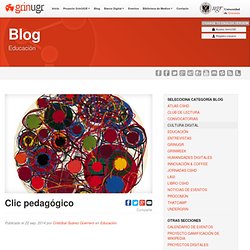
A Tech Geek on Why We Need the Humanities. What's the Big Idea?
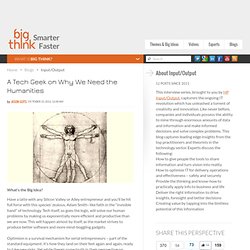
Have a latte with any Silicon Valley or Alley entrepreneur and you’ll be hit full force with this species’ zealous, Adam Smith–like faith in the “invisible hand” of technology. Tech itself, so goes the logic, will solve our human problems by making us exponentially more efficient and productive than we are now. This will happen almost by itself, as the market strives to produce better software and more mind-boggling gadgets.
Optimism is a survival mechanism for serial entrepreneurs – part of the standard equipment. It’s how they land on their feet again and again, ready to take new risks.